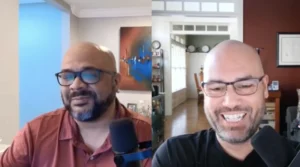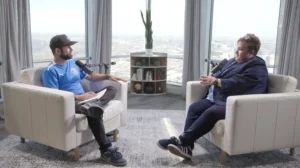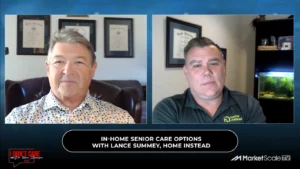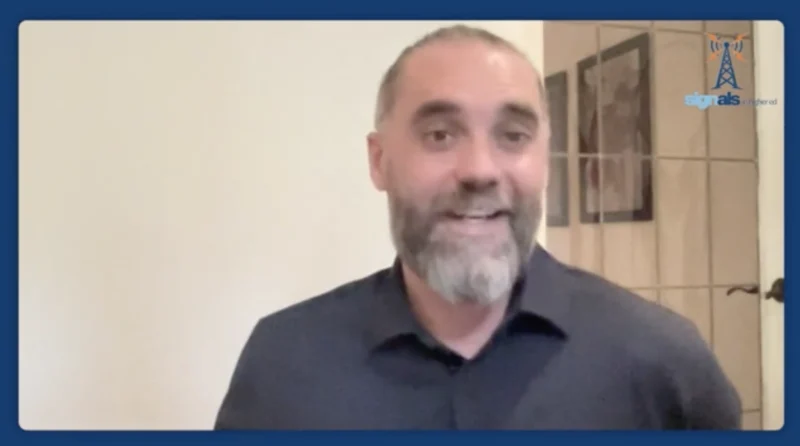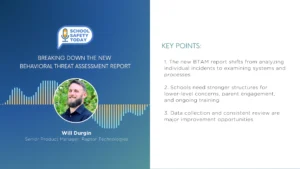How COVID-19 Will Force Education Into The Future
This post originally appeared on the ASCD website. Sean Slade is the Senior Director of Global Outreach at ASCD, focusing on promoting and expanding the ASCD Whole Child approach across the United States and globally. Look for his interview on an upcoming episode of Remote Possibilities.
In decades to come, the first months of 2020 will be seen as a watershed moment. It will be looked upon as a moment that changed the way we operate and the way we perceive ourselves, our communities, and our purpose.
Education is not, and will not, be immune from this change and, in fact, many of the changes are happening so rapidly that many of us are too busy to see them occurring before our own eyes.
The Covid-19 crisis will force – and is forcing – education a decade into the future. While there will be benefits to this “leapfrogging,” borrowing a phrase from the Brookings Institution, in the way we educate – how we educate, where we educate, and most importantly why we educate – there will also be casualties of this leap into the future and many of these will be as a result of existing inequity.
Full disclosure, many of these items have been discussed and practiced by many schools for years, and, as such, are not new. The new difference is that they will quickly become mainstream. They echo the work that came out of the OECD/CERI 2001 What Schools for the Future report, the Brookings Institution work on Learning to Leapfrog, and are also a core part of the OECD Future of Education 2030 Project.
Here’s what we are hearing.
Learning Communities
Due to Covid-19, we are all already in learning communities and this is only expected to grow. Learning communities are spaces in which learning takes place across the setting, amongst the people there, and with their combined resources and knowledge. It is stepping away from having didactic instruction where teacher preaches, and the students listen. It is acknowledging that we are all learning all the time.
Our learning communities can be our classrooms, whether they are in person or, as we are now, online. They can be across our school, and they can be across and amongst our physical locations. Ultimately, we will be seeing these learning communities expand into and across all our communities– physical and online – and our schools and classrooms transform into pedagogical centers where learning is guided rather than delivered. Many students have been doing this via online YouTube videos and other instructional sites, though typically as an individual learner seeking information and guidance. Many teachers have been doing this also via social media professional learning such as Twitter Chats and PLCs (Professional Learning Communities). What we are moving towards, however, are learning communities that encompass the standard K-12 experience, bringing together learning for and with students, and the professional learning and growth of our teachers.
Student Agency
The most successful schools and classrooms dealing with this crisis have been then ones that have developed a sense of student agency and ownership over their own learning. Trying to replicate a standard, traditional classroom where the teacher is constantly present does not work as we teach and learn remotely. Students needs to develop an understanding of their own role in the learning process and be expected and encouraged to see themselves more as agents, or ideally owners, of their own learning. For such ownership and agency to be developed students will need to assume greater responsibility, understand new expectations, and be introduced to this new or growing role in stages. Taking ownership, and agency, should be seen by both teachers and learners to be a process, and not the flicking of a switch. Luckily for many schools and educators they are already well down this path via project based leaning, student-led and directed activities, and policies that develop and grow student voice. We must however continue to purposefully develop students sense of themselves as partners in the learning process and not just recipients.
Guide on the Side
Such changes to student identity, however, will only be successful if we the educators review our role from Sage on the Stage to Guide on the Side. These terms have been floating around the educational community for several decades now and while many have moved on to change their roles to be that of the pedagogical expert and curator of learning, many others have been stuck – wittingly or unwittingly, often constrained by antiquated educational policy and processes – in the status quo.
But the status quo that we are in now, and will likely continue to be in from here on, is one of change and adjustment. We are very much in a VUCA world – one that is Volatile, Uncertain, Complex, and Ambiguous – and even when our current crisis rescinds, the volatility and complexity of our world will likely continue. As Yong Zhao said in his intriguingly titled opinion piece Tofu is not Cheese: Reimagine Education without Schools During Covid19, “now is the time to stop and rethink what’s worth teaching and learning. We have a rare opportunity to examine what we have always been teaching (or trying to) …”
Learning to Learn
We have an opportunity here to move expeditiously into a future stage, of utilizing this crisis to upend an antiquated system, and to replace it with one that engages the learner in learning and teaches them to learn how to learn. Universal content mastery is becoming less important, just as creativity, problem solving, and creating new knowledge is becoming more. As Rebecca Winthrop, from the Brookings Institution, wrote in The Learning Compact Renewed: Whole Child for the Whole World (2020) “Education needs to provide all children, even those accessing good schools today, with the ability to navigate an increasingly uncertain future. Young people need educational experiences that develop their capacity for lifelong learning, and to do this, they need schooling to focus on the full breadth of skills. Academic rigor is no longer sufficient, and in some cases such a focus can be detrimental if it reduces the emphasis on learning how to learn, how to communicate, how to problem solve and how to develop your own self.”
Well-being
The self, the person, the whole person. If there is one gratifying outcome of the crisis, it has been our almost universal reappreciation of the need to focus more on our individual and collective wellbeing. Whether it has been the community-bonding performances in Italy, or the daily city-wide applause and gratitude displayed in NYC, our health and wellbeing has been at the forefront. Teachers, educators and principals have also been driving this message focusing on reducing anxiety, building community, focusing on feelings of safety amongst their students. And districts along with Education Support Professionals have been striving to ensure that basic food and nutrition access is maintained. Wellbeing is being pushed to the front of the educational priority to do list. This is very much a clear example of the need to focus on Maslow before we focus on Bloom.
A key example of this both across our schools and across our neighborhoods has been the emphasis placed upon movement, exercise and play. As William Doyle & Pasi Sahlberg wrote recently in The Washington Post, “In this health emergency, government leaders around the world are urgently seeking the advice of medical and scientific experts. They should do the same when it comes to education. When the covid-19 pandemic passes and the world opens up again, we should redesign our schools using the best expert evidence, just as we are doing in response to the global health pandemic. We should give our children schools that follow doctor’s orders, by giving them lots of physical activity and play to energize learning and boost health and happiness.”
And knowing (not just thinking) that we are interconnected
This crisis has also opened our eyes to the fact – not just the hypothesis – that we are all connected, interconnected to our communities, our broader society, and to the globe. This has been a global pandemic that has illustrated quite definitively that what occurs in one region can and often does affect another, and another.
In an article written as part of The Learning Compact Renewed just prior to the Covid-19 crisis, Teaching with and for the World, Dennis Shirley and Pak Tee Ng outline our reality and future necessity.
“Educators around the world are confronting a tsunami of change forces today like never before. The prospects for us all are changing with breathtaking speed as a result of new technological capacity, population mobility, political turbulence, economic volatility, and environmental fragility. The very definition of what it means to teach, live, and learn with others in ways that promote the common good is transforming before our eyes.
To meet these interrelated challenges, educators can no longer focus just on their immediate location or even solely their own country. Rather, the world now needs educators with global reach who understand the nature of human interdependence in a world characterized by the acceleration of change. Educators today are tasked with preparing a rising generation to seize the opportunities available to secure peace, enhance prosperity, and promote better understanding and harmony among different peoples.“
Inequities
Change, however, is not always positive and those with fewer supports often suffer the most in the midst of change. Crises such as this highlight, expand, and exacerbate inequities. This crisis, while providing an opportunity and window for change, however will not solve our inequities and will instead superpower them unless we also act to change and confront them. From a lack of resources, to underfunded schools, communities, and support services, this crisis is hitting those who need more support, not less, the most. The virus may not discriminate but our varying and inequitable systems of support do.
This crisis is hitting our underserved communities the hardest and from an educational perspective, these are students who may not have access to internet or to a library, who may not have food that day or methods to feel connected to classes, schools and communities because of lock-downs. These are the students who need our support the most. As David Griffih wrote in The Conversation We Are Not Having About Coronavirus:
“Aside from missing daily instruction – which can be made up with extra school days at the end of the year – the biggest loss associated with school closings is the 22 million free and reduced-price breakfasts and lunches served by schools every day. For too many students, these are the main nutritious meals they get on a daily basis — a reality teleschooling doesn’t address. It’s not just learning and nutrition that students miss either. For many students, school is the primary place — and sometimes the only place — where they interact daily with caring adults in a supportive relationship, adults who recognize their talents and potential as individuals.”
This crisis will change our societies and communities, and will very likely force our education systems into a new reality. While we cannot control everything, we can control how we respond and react to situations. We do have a role to play as both members of society and as educators to envisage what changes we want and need – and what we don’t – and we must play our role in affecting those desired changes.
We are on a fast-track process to try and plan what our future education systems should look like and what world we want our children to inherit. One with learning, community, agency, wellbeing at its core or one dictated by antiquities and inequalities.


